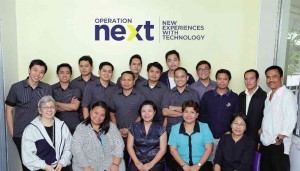Xavier leads the way in integrating technology
(First of two parts)
Good teachers teach well, with or without technology. Bad teachers teach poorly, with or without technology.
The best teachers vary their methods based on their students’ different needs. They use PowerPoint, graphing calculators, websites or just plain chalkboard.
Instead of forcing all teachers to go high-technology, no matter what, sensible schools provide them various options and train them to decide when to use what.
Supplement, not replace
“From the start, technology was never meant to replace the teacher,” says Galvin Ngo, head of Xavier School’s NExT team, “but rather to supplement and enhance learning.”
NExT stands for New Experiences with Technology.
One supposed advantage of computers is that, instead of carrying heavy bags, students just bring a single lightweight device.
“Many people tend to think this way,” says Ngo. “But for us, it is not so much about school bags, but enriching learning. We are not doing away with traditional methods.”
Xavier students still do mathematics exercises using pen and paper. Problems are solved on paper in notebooks or textbooks. Studies show that, at least in math, nothing beats an agile mind, pen and paper or chalk and board.
“Sometimes technology is helpful, such as doing a presentation to a big class,” says Jessica Demegillo, a member of the NExT team.
“But we don’t need to use tech all the time,” says Ngo. “If a topic needs pen and paper, then use them.”
Demegillo gives an example of how low- and hi-tech can enhance each other. “Our English teachers first teach communication the (usual) way; afterwards, we can introduce [video-conferencing] apps such as FaceTime.”
“Sometimes tech is used as a hook for the lesson,” says Ngo. “But it cannot stop there. Educational tech must be grounded in real teaching strategies to promote deeper discussion and critical thinking.”
Take Mind Maps. Students brainstorm ideas on a topic, then make associations by using diagrams on paper or on the board. Mind Maps can also be done on screen. Students are always the ones doing the thinking.
Long thought-out process
How do teachers know when and how to use technology? How do they know which devices, websites, tools are appropriate?
This is where research and experimentation can help.
Technology integration in Xavier is based on Ignatian pedagogy, after Jesuit founder St. Ignatius of Loyola.
“We learn how to learn,” says Ngo.
First, context: When, where, how does good learning take place? Second, experience: What happens in the real classroom when certain methods are applied? Third, reflection: Which strategies best suit the given environment?
Fourth and last, action: What actions do we take based on what we have learned in the first three steps?
“[W]e did not fast-track tech use in Xavier,” says Ngo. “We took incremental steps and the process took many years.”
Several schools leaped into technology, with mixed results. The seduction of technology is such that schools, parents, government and business groups believe that tablets or laptops are the magic pills for instruction and learning.
Xavier took a lengthy but sensible approach. The process started in 2006, with the encouragement of former director Johnny Go, S.J., an experienced tech user. For two years, selected faculty researched and experimented on varied ways of integrating technology into learning.
In school year 2008-2009, some components of what would become the One2One Learning Program were tried by selected classes in (Apple) Mac Labs. Each student was provided a device for his individual use.
One2One was a huge hit with students but, more importantly, the experience proved that teachers were on the right track.
Xavier still took its time. Instead of requiring students in all grade levels to get their own laptops immediately, in 2009-2010, the school selected only one class—an honors English class—to try out Macbooks.
Interested faculty members were encouraged to use Macbook Carts, with devices to help them use tech in different subjects.
Training and support
School year 2010-2011 was a turning point, with the official launch of Operation NExT. The NExT team visited model schools abroad to identify best practices in integrating technology, particularly Apple’s.
NExT is double-pronged: Information technology personnel provide on-demand tech support; and computer education personnel offer training to faculty and staff.
Many schools, eager to computerize, fail to update their infrastructure. Teachers complain that they waste time waiting for Web pages to upload.
Xavier is one of the most wired campuses in the country and hardware improvements are still ongoing.
“Since 2010, we have begun a major upgrade,” says Ngo, “including the purchase of access points for each classroom.”
“We cannot just say: ‘Here is the technology, bahala na,’” says Ngo. “If we are serious about promoting tech, then we don’t want teachers and students getting frustrated. Or else we lose their support and our efforts fail.”
Ngo adds, “We need to keep abreast of the changing needs of students and to encourage and support teachers, especially those having a hard time coping with tech. We need to listen to their concerns and act as a bridge among students, teachers, parents and administration.”
(To be continued next week)
E-mail the author at [email protected].
